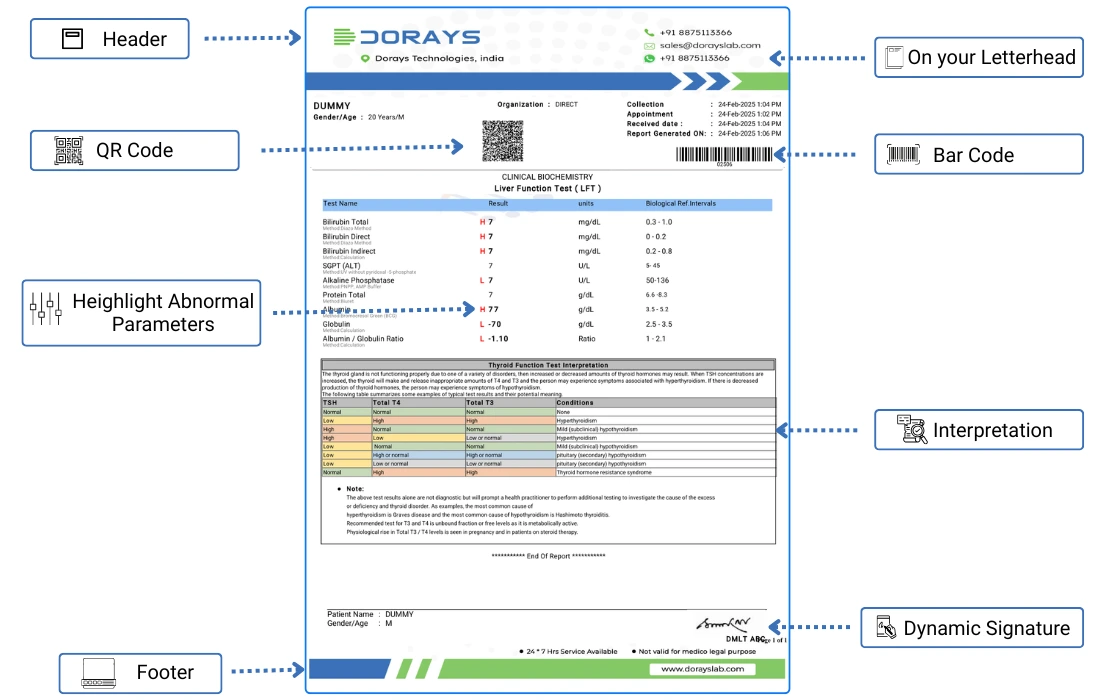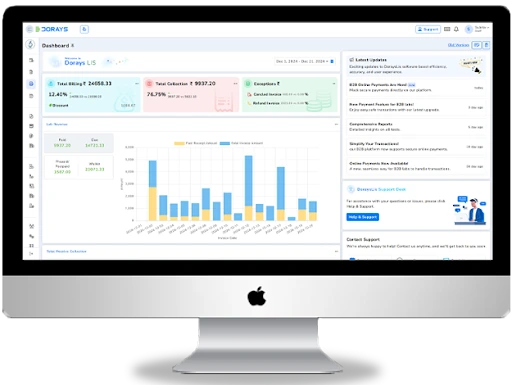Serum Electrolytes Report Format

Download Report Sample
Explore cutting-edge diagnostics. One click to preview your report sample.
What are Serum Electrolytes?
Serum electrolytes are essential minerals found in the blood that help maintain various body functions, including fluid balance, nerve function, and muscle contraction. Measuring the levels of electrolytes is vital for assessing overall health and diagnosing conditions such as dehydration, kidney disease, and metabolic disorders.
What is a Serum Electrolytes Report Format?
A serum electrolytes report includes the measured concentrations of key electrolytes in the blood, offering insights into hydration status, kidney function, and acid-base balance. The report is crucial for identifying conditions like hyponatremia, hyperkalemia, and imbalances related to various disorders.
Tests Included in Serum Electrolytes Report
Test | Description |
Sodium (Na+) | Measures the level of sodium, a key electrolyte for fluid balance and nerve function. |
Potassium (K+) | Measures the level of potassium, essential for muscle function, heart health, and nerve signaling. |
Chloride (Cl-) | Measures chloride, a key electrolyte that works closely with sodium to maintain fluid balance. |
Bicarbonate (HCO3-) | Measures bicarbonate, involved in regulating the body's acid-base balance. |
Calcium (Ca2+) | Measures total calcium, important for bone health, muscle function, and nerve transmission. |
Magnesium (Mg2+) | Measures magnesium, essential for enzyme function, muscle relaxation, and nerve function. |
Key Parts of a Serum Electrolytes Report
Key Part | Description |
Sample Type | Blood sample, typically from a vein (serum). |
Test Method | Commonly analyzed using methods like Ion-Selective Electrode (ISE) or Colorimetric Assays. |
Measured Value | Electrolyte levels reported in units like mEq/L, mmol/L, or mg/dL. |
Reference Range | Varies based on age, sex, and lab-specific methods. |
Interpretation | Provides clinical insights based on electrolyte levels and symptoms. |
Normal Range for Serum Electrolytes Report
Test | Reference Range (Approximate) |
Sodium (Na+) | 135 – 145 mEq/L |
Potassium (K+) | 3.5 – 5.0 mEq/L |
Chloride (Cl-) | 98 – 107 mEq/L |
Bicarbonate (HCO3-) | 22 – 29 mEq/L |
Calcium (Ca2+) | 8.5 – 10.2 mg/dL |
Magnesium (Mg2+) | 1.7 – 2.2 mg/dL |
Parameters to Consider in Serum Electrolyte Report
Parameter | Interpretation |
High Sodium (Hypernatremia) | Suggests dehydration, kidney dysfunction, or excessive salt intake. |
Low Sodium (Hyponatremia) | Indicates fluid overload, kidney failure, or hormonal imbalances. |
High Potassium (Hyperkalemia) | May suggest kidney failure, dehydration, or excessive potassium intake. |
Low Potassium (Hypokalemia) | Can indicate dehydration, diarrhea, or diuretic use. |
High Chloride (Hyperchloremia) | Often associated with dehydration, kidney disease, or acidosis. |
Low Chloride (Hypochloremia) | Can indicate fluid loss, metabolic alkalosis, or respiratory disorders. |
High Calcium (Hypercalcemia) | Suggests hyperparathyroidism, cancer, or kidney disease. |
Low Calcium (Hypocalcemia) | Can indicate vitamin D deficiency, hypoparathyroidism, or kidney disease. |
High Magnesium (Hypermagnesemia) | May indicate kidney failure or excessive magnesium supplementation. |
Low Magnesium (Hypomagnesemia) | Can be caused by malnutrition, alcohol use, or gastrointestinal disorders. |
Clinical Context
- Sodium and Potassium: Both electrolytes are crucial for maintaining fluid balance and conducting electrical impulses in nerves and muscles. Sodium levels can indicate hydration status, while potassium levels are vital for heart and muscle function.
- Calcium: Calcium imbalance can impact bone health, muscle function, and nerve transmission. Abnormal levels may be related to parathyroid disorders or kidney disease.
- Chloride and Bicarbonate: Both of these electrolytes help in maintaining the body's acid-base balance. Abnormal levels may indicate conditions like acidosis or alkalosis.
- Magnesium: Essential for muscle function, magnesium imbalance can lead to issues like muscle cramps, arrhythmias, and weakness.
Guidelines for Serum Electrolytes Report Format
Guideline | Description |
Units Consistency | Ensure electrolyte levels are reported in consistent units (mEq/L, mmol/L, mg/dL). |
Fasting Requirements | Fasting is generally not required for serum electrolyte testing. |
Interpretation Support | Additional tests (such as kidney function tests or hormone panels) may be necessary to identify the cause of electrolyte imbalances. |
What Do the Results Mean?
Result Type | Interpretation |
Normal Electrolytes | Suggests balanced fluid and electrolyte levels, with proper kidney and organ function. |
Elevated Sodium | Indicates dehydration, kidney dysfunction, or excessive salt intake. |
Low Sodium | Could suggest excessive fluid retention or kidney dysfunction. |
Elevated Potassium | Suggests kidney failure, dehydration, or excessive potassium intake. |
Low Potassium | Could indicate dehydration, gastrointestinal issues, or use of diuretics. |
Elevated Calcium | May indicate hyperparathyroidism or certain cancers. |
Low Calcium | Suggests vitamin D deficiency, parathyroid disorders, or kidney disease. |
Elevated Magnesium | Indicates kidney dysfunction or excessive magnesium intake. |
Low Magnesium | May suggest malnutrition, alcohol use, or gastrointestinal disorders. |
Serum Electrolytes Report Interpretation
Test | Interpretation |
Sodium | Key for fluid balance and nerve function; abnormal levels may indicate dehydration, kidney issues, or hormonal imbalances. |
Potassium | Important for heart and muscle function; abnormal levels require prompt attention. |
Chloride | Works with sodium to maintain fluid balance; imbalances could indicate acid-base disturbances. |
Bicarbonate | Regulates the acid-base balance of the body; abnormal levels may indicate respiratory or metabolic disorders. |
Calcium | Vital for bones and muscles; abnormal levels may suggest endocrine or kidney dysfunction. |
Magnesium | Crucial for muscle and nerve function; abnormal levels may indicate issues with kidney function or nutrition. |

Effortless Lab Management Starts Here!
Experience the future of lab operations. One click to revolutionize your lab.





